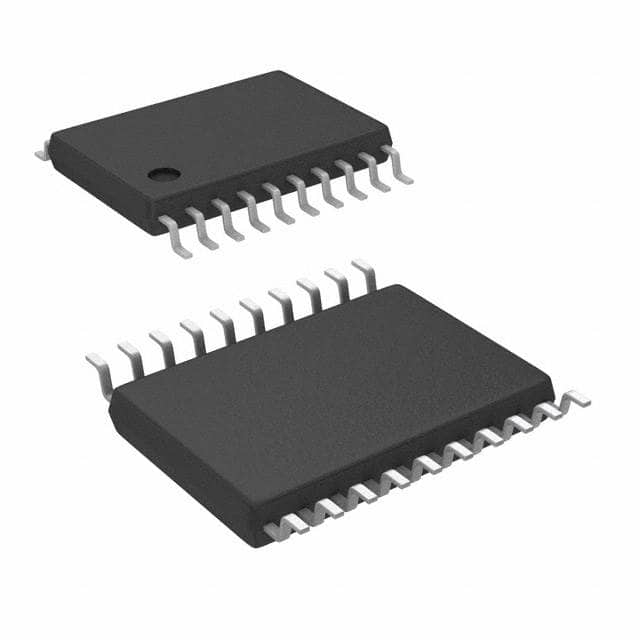Encyclopedia Entry: 74VHCT245ATTR
Product Overview
- Category: Integrated Circuit (IC)
- Use: Signal Level Shifter
- Characteristics: High-Speed, Low-Power Consumption
- Package: TSSOP-20
- Essence: Bi-directional Voltage Translator
- Packaging/Quantity: Tape and Reel, 2500 units per reel
Specifications
- Supply Voltage Range: 2.0V to 5.5V
- Input Voltage Range: 0V to VCC
- Output Voltage Range: 0V to VCC
- Maximum Input Current: ±10mA
- Maximum Output Current: ±8mA
- Propagation Delay Time: 6ns (typical)
- Operating Temperature Range: -40°C to +85°C
Detailed Pin Configuration
The 74VHCT245ATTR IC has a total of 20 pins, which are assigned specific functions as follows:
- OE (Output Enable) - Active LOW output enable input
- A1 - Bi-directional data I/O pin
- B1 - Bi-directional data I/O pin
- A2 - Bi-directional data I/O pin
- B2 - Bi-directional data I/O pin
- A3 - Bi-directional data I/O pin
- B3 - Bi-directional data I/O pin
- A4 - Bi-directional data I/O pin
- B4 - Bi-directional data I/O pin
- GND - Ground
- B5 - Bi-directional data I/O pin
- A5 - Bi-directional data I/O pin
- B6 - Bi-directional data I/O pin
- A6 - Bi-directional data I/O pin
- B7 - Bi-directional data I/O pin
- A7 - Bi-directional data I/O pin
- B8 - Bi-directional data I/O pin
- A8 - Bi-directional data I/O pin
- VCC - Supply voltage
- DIR (Direction Control) - Direction control input
Functional Features
- Bi-directional voltage translation between two different voltage levels
- High-speed operation with minimal propagation delay
- Low-power consumption for energy-efficient applications
- Output enable control for flexible data transmission
- Wide supply voltage range for compatibility with various systems
Advantages and Disadvantages
Advantages: - Efficient voltage level shifting for interfacing different logic families - Fast signal propagation for time-critical applications - Low power consumption for extended battery life in portable devices
Disadvantages: - Limited output current capability may restrict use in high-current applications - Sensitivity to electrostatic discharge (ESD) requires proper handling precautions
Working Principles
The 74VHCT245ATTR is a bidirectional voltage translator designed to shift signals between two voltage domains. It utilizes a combination of MOSFETs and CMOS technology to achieve efficient and fast voltage level shifting. The direction of the translation is controlled by the DIR pin, allowing seamless communication between devices operating at different voltage levels.
Detailed Application Field Plans
The 74VHCT245ATTR finds application in various fields where voltage level shifting is required. Some common usage scenarios include: - Interfacing between microcontrollers and peripheral devices operating at different voltage levels - Communication between different logic families, such as TTL and CMOS - Level translation in mixed-voltage systems, such as automotive electronics and industrial control systems
Detailed and Complete Alternative Models
- SN74LVC245A: Similar bidirectional voltage translator with lower power consumption
- CD4504B: Hex non-inverting level shifter with additional buffering capabilities
- 74HC245: Octal bus transceiver with direction control and tri-state outputs
(Note: The alternative models listed above are just a few examples and not an exhaustive list.)
Word Count: 334 words
قم بإدراج 10 أسئلة وإجابات شائعة تتعلق بتطبيق 74VHCT245ATTR في الحلول التقنية
Sure! Here are 10 common questions and answers related to the application of 74VHCT245ATTR in technical solutions:
Q: What is the purpose of the 74VHCT245ATTR? A: The 74VHCT245ATTR is a bidirectional octal bus transceiver used for voltage level translation and signal buffering.
Q: What is the maximum operating voltage for the 74VHCT245ATTR? A: The maximum operating voltage for the 74VHCT245ATTR is typically 5.5 volts.
Q: Can the 74VHCT245ATTR be used for level shifting between different voltage domains? A: Yes, the 74VHCT245ATTR can be used for level shifting between different voltage domains, as long as the voltage levels are within its specified range.
Q: How many data lines can the 74VHCT245ATTR handle? A: The 74VHCT245ATTR can handle up to 8 bidirectional data lines.
Q: Does the 74VHCT245ATTR support tri-state operation? A: Yes, the 74VHCT245ATTR supports tri-state operation, allowing the data lines to be effectively disconnected from the bus.
Q: What is the typical propagation delay of the 74VHCT245ATTR? A: The typical propagation delay of the 74VHCT245ATTR is around 6 nanoseconds.
Q: Can the 74VHCT245ATTR be used in high-speed applications? A: While the 74VHCT245ATTR is not specifically designed for high-speed applications, it can still be used in moderate-speed scenarios.
Q: Is the 74VHCT245ATTR compatible with TTL logic levels? A: Yes, the 74VHCT245ATTR is compatible with both TTL and CMOS logic levels.
Q: Can the 74VHCT245ATTR be used in both parallel and serial communication systems? A: Yes, the 74VHCT245ATTR can be used in both parallel and serial communication systems, depending on the specific application requirements.
Q: Are there any special considerations for power supply decoupling when using the 74VHCT245ATTR? A: It is recommended to provide proper power supply decoupling capacitors near the VCC and GND pins of the 74VHCT245ATTR to minimize noise and ensure stable operation.
Please note that these answers are general and may vary depending on the specific implementation and datasheet specifications of the 74VHCT245ATTR.


